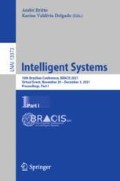Abstract
The extensive exploration of the Low Earth Orbit (LEO) has created a dangerous spacial environment, where space debris has threatened the feasibility of future operations. In this sense, Active Debris Removal (ADR) missions are required to clean up the space, deorbiting the debris with a spacecraft. ADR mission planning has been investigated in the literature by means of metaheuristic approaches, focused on maximizing the amount of removed debris given the constraints of the spacecraft. The state-of-the-art approach uses an inver-over and maximal open walk algorithms to solve this problem. However, that approach fails to deal with large instances and duration constraints. This work extends the state of the art, increasing its performance and modeling all the constraints. Experimental results evidence the improvements over the original approach, including the ability to run for scenarios with thousands of debris.
Access this chapter
Tax calculation will be finalised at checkout
Purchases are for personal use only
References
Barea, A., Urrutxua, H., Cadarso, L.: Large-scale object selection and trajectory planning for multi-target space debris removal missions. Acta Astronautica 170, 289–301 (2020). https://doi.org/10.1016/j.actaastro.2020.01.032
Braun, V., et al.: Active debris removal of multiple priority targets. Adv. Space Res. 51(9), 1638–1648 (2013)
Cerf, M.: Multiple space debris collecting mission-debris selection and trajectory optimization. J. Optim. Theor. Appl. 156, 761–796 (2013). https://doi.org/10.1007/s10957-012-0130-6
Cerf, M.: Multiple space debris collecting mission: optimal mission planning. J. Optim. Theor. Appl. 167(1), 195–218 (2015). https://doi.org/10.1007/s10957-015-0705-0
Koblick, D., et al.: Low thrust minimum time orbit transfer nonlinear optimization using impulse discretization via the modified picard-chebyshev method. Comput. Model. Eng. Sci. 111(1), 1–27 (2016). https://doi.org/10.3970/cmes.2016.111.001
Edelbaum, T.N.: Propulsion requirements for controllable satellites. ARS J. 31(8), 1079–1089 (1961). https://doi.org/10.2514/8.5723
Federici, L., Zavoli, A., Colasurdo, G.: A time-dependent tsp formulation for the design of an active debris removal mission using simulated annealing (2019)
Flood, M.M.: The traveling-salesman problem. Oper. Res. 4(1), 61–75 (1956). https://doi.org/10.1287/opre.4.1.61
Izzo, D., Getzner, I., Hennes, D., Simões, L.F.: Evolving solutions to tsp variants for active space debris removal. In: Proceedings of the 2015 Annual Conference on Genetic and Evolutionary Computation, pp. 1207–1214. GECCO ’15, ACM (2015)
Johnson, D., McGeoch, L.A.: The traveling salesman problem: A case study in local optimization (2008)
Kanazaki, M., Yamada, Y., Nakamiya, M.: Trajectory optimization of a satellite for multiple active space debris removal based on a method for the traveling serviceman problem. In: 2017 21st Asia Pacific Symposium on Intelligent and Evolutionary Systems (IES), pp. 61–66 (2017). https://doi.org/10.1109/IESYS.2017.8233562
Kessler, D.J., Cour-Palais, B.G.: Collision frequency of artificial satellites: the creation of a debris belt. J. Geophys. Res. Space Phys. 83(A6), 2637–2646 (1978). https://doi.org/10.1029/JA083iA06p02637
Li, H., Baoyin, H.: Optimization of multiple debris removal missions using an evolving elitist club algorithm. IEEE Trans. Aerospace Electron. Syst. 56(1), 773–784 (2020). https://doi.org/10.1109/TAES.2019.2934373
Li, H.Y., Baoyin, H.X.: Sequence optimization for multiple asteroids rendezvous via cluster analysis and probability-based beam search. Sci. Chin. Technol. Sci. 64(1), 122–130 (2020). https://doi.org/10.1007/s11431-020-1560-9
Liou, J.C.: An active debris removal parametric study for leo environment remediation. Adv. Space Res. 47(11), 1865–1876 (2011). https://doi.org/10.1016/j.asr.2011.02.003
Liou, J.C., Johnson, N.: Instability of the present leo satellite populations. Adv. Space Res. 41(7), 1046–1053 (2008). https://doi.org/10.1016/j.asr.2007.04.081
Liou, J.C., Johnson, N., Hill, N.: Controlling the growth of future leo debris populations with active debris removal. Acta Astronautica 66(5), 648–653 (2010). https://doi.org/10.1016/j.actaastro.2009.08.005
Liu, Y., Yang, J., Wang, Y., Pan, Q., Yuan, J.: Multi-objective optimal preliminary planning of multi-debris active removal mission in LEO. Sci. Chin. Inform. Sci. 60(7), 1–10 (2017). https://doi.org/10.1007/s11432-016-0566-7
Madakat, D., Morio, J., Vanderpooten, D.: Biobjective planning of an active debris removal mission. Acta Astronautica 84, 182–188 (2013). https://doi.org/10.1016/j.actaastro.2012.10.038
Seumahu, E.S.: Exploration of the Equatorial LEO Orbit for Communication and Other Applications, pp. 217–228. Springer, Netherlands, Dordrecht (1996). https://doi.org/10.1007/978-94-011-5692-9_25
Stuart, J., Howell, K., Wilson, R.: Application of multi-agent coordination methods to the design of space debris mitigation tours. Adv. Space Res. 57(8), 1680–1697 (2016). https://doi.org/10.1016/j.asr.2015.05.002
Tao, G., Michalewicz, Z.: Inver-over operator for the TSP. In: Eiben, A.E., Bäck, T., Schoenauer, M., Schwefel, H.-P. (eds.) PPSN 1998. LNCS, vol. 1498, pp. 803–812. Springer, Heidelberg (1998). https://doi.org/10.1007/BFb0056922
Vallado, D., Crawford, P.: SGP4 Orbit Determination, pp. 18–21 (2008). https://doi.org/10.2514/6.2008-6770
Wang, D., Li, L., Chen, L.: An efficient genetic algorithm for active space debris removal planning. In: 2019 IEEE Congress on Evolutionary Computation (CEC), pp. 514–521 (2019). https://doi.org/10.1109/CEC.2019.8790081
Yang, J., Hou, X., Hu, Y.H., Liu, Y., Pan, Q.: A reinforcement learning scheme for active multi-debris removal mission planning with modified upper confidence bound tree search. IEEE Access 8, 108461–108473 (2020)
Yang, J., Hu, Y.H., Liu, Y., Pan, Q.: A maximal-reward preliminary planning for multi-debris active removal mission in leo with a greedy heuristic method. Acta Astronautica 149, 123–142 (2018). https://doi.org/10.1016/j.actaastro.2018.05.040
Zhang, T., Shen, H., Li, H., Li, J.: Ant Colony Optimization based design of multiple-target active debris removal mission (2018). https://doi.org/10.2514/6.2018-2412
Acknowledgements
We thank the anonymous reviewers for their constructive feedback. This work was partially supported by FAPERGS (grant 19/2551-0001277-2).
Author information
Authors and Affiliations
Corresponding authors
Editor information
Editors and Affiliations
Rights and permissions
Copyright information
© 2021 Springer Nature Switzerland AG
About this paper
Cite this paper
Rodrigues Neto, J.B., de Oliveira Ramos, G. (2021). An Enhanced TSP-Based Approach for Active Debris Removal Mission Planning. In: Britto, A., Valdivia Delgado, K. (eds) Intelligent Systems. BRACIS 2021. Lecture Notes in Computer Science(), vol 13073. Springer, Cham. https://doi.org/10.1007/978-3-030-91702-9_10
Download citation
DOI: https://doi.org/10.1007/978-3-030-91702-9_10
Published:
Publisher Name: Springer, Cham
Print ISBN: 978-3-030-91701-2
Online ISBN: 978-3-030-91702-9
eBook Packages: Computer ScienceComputer Science (R0)

